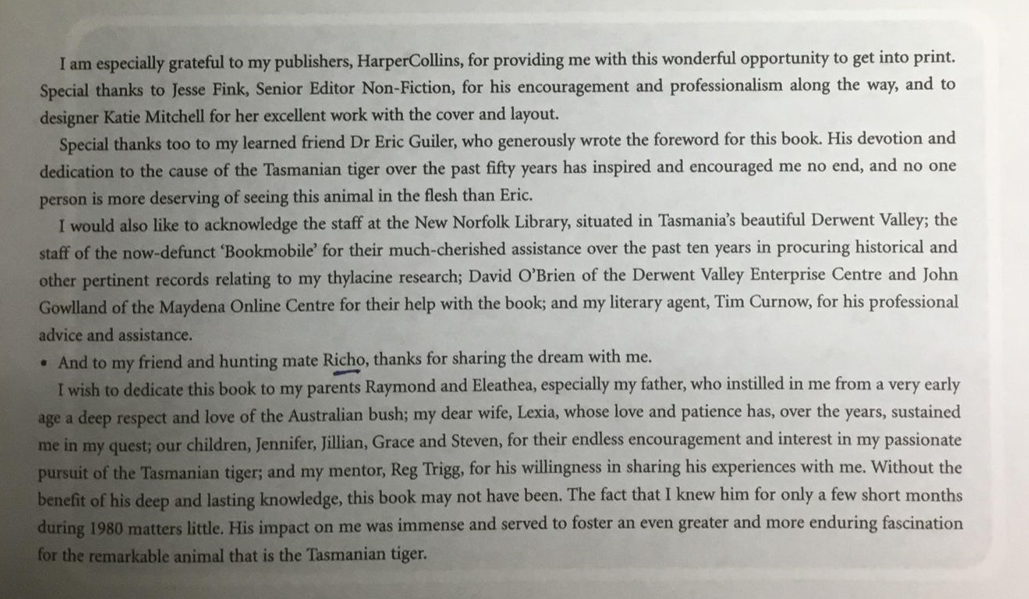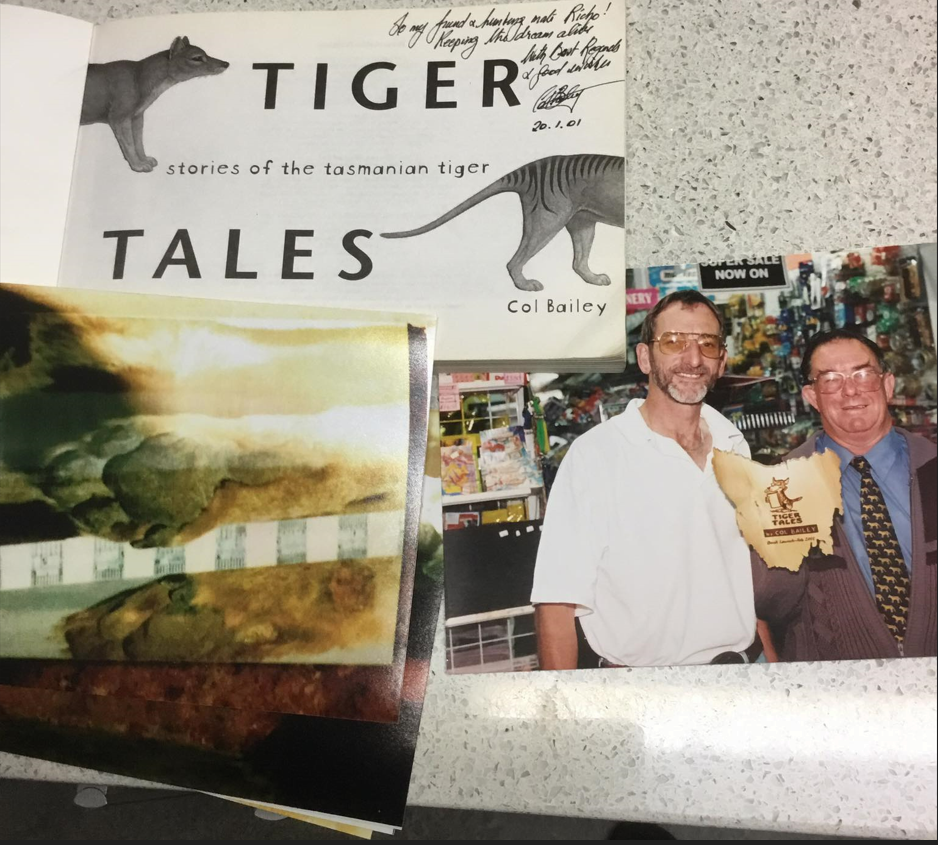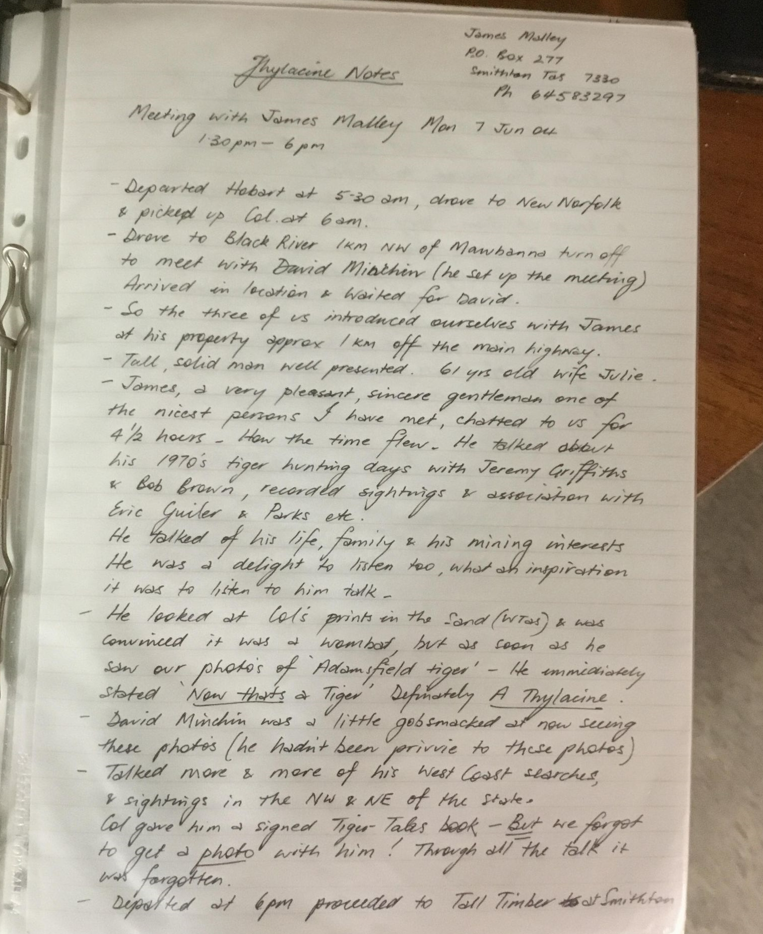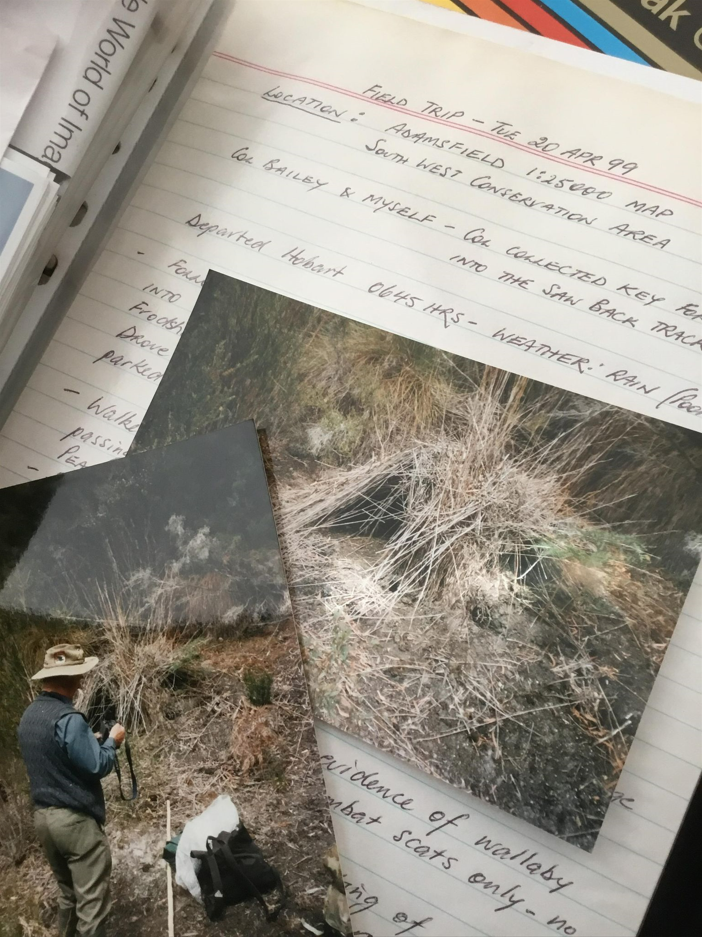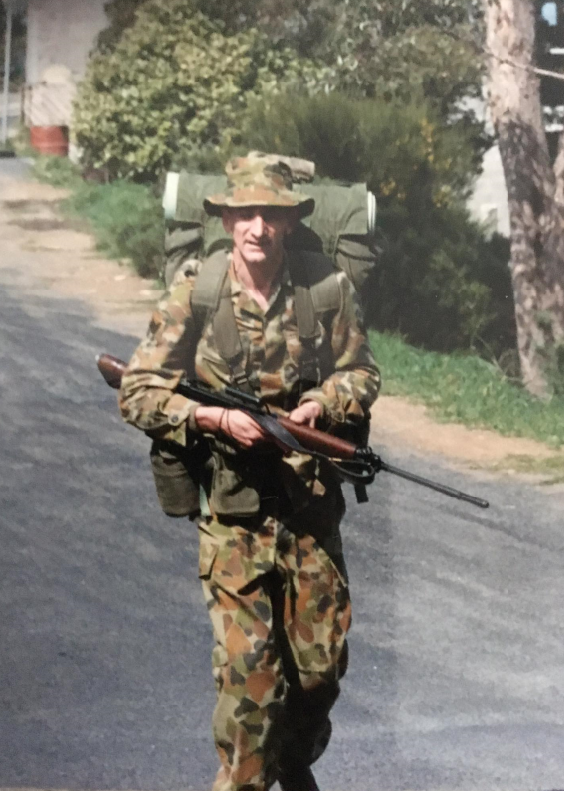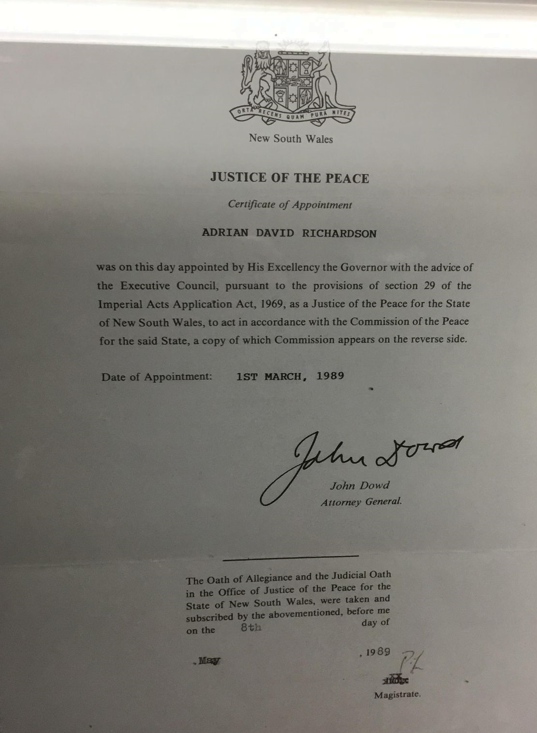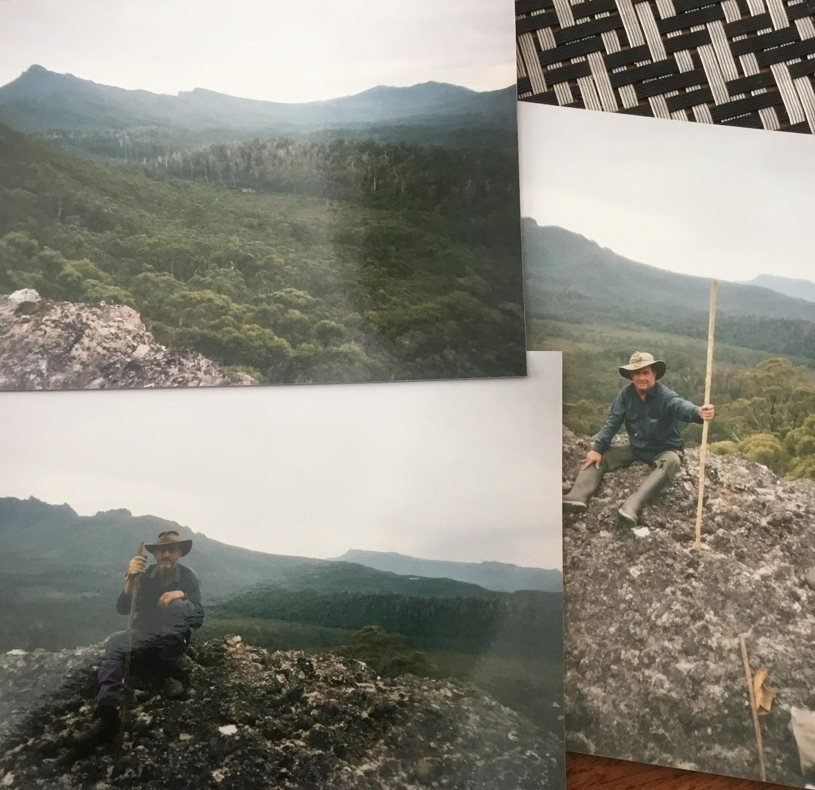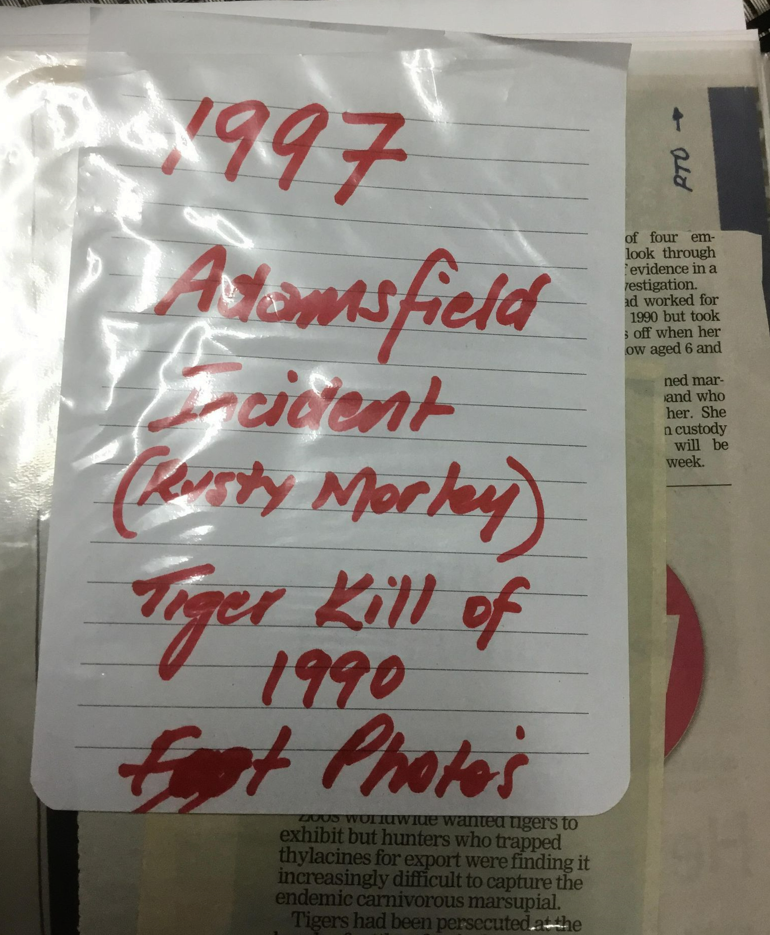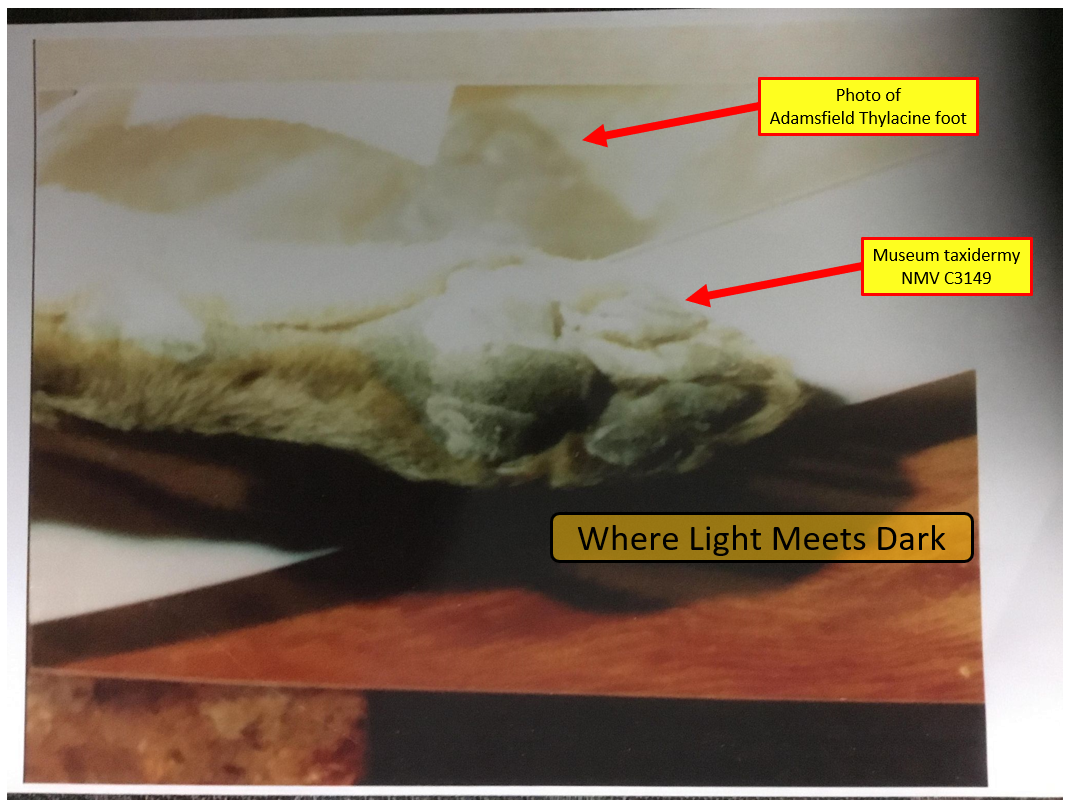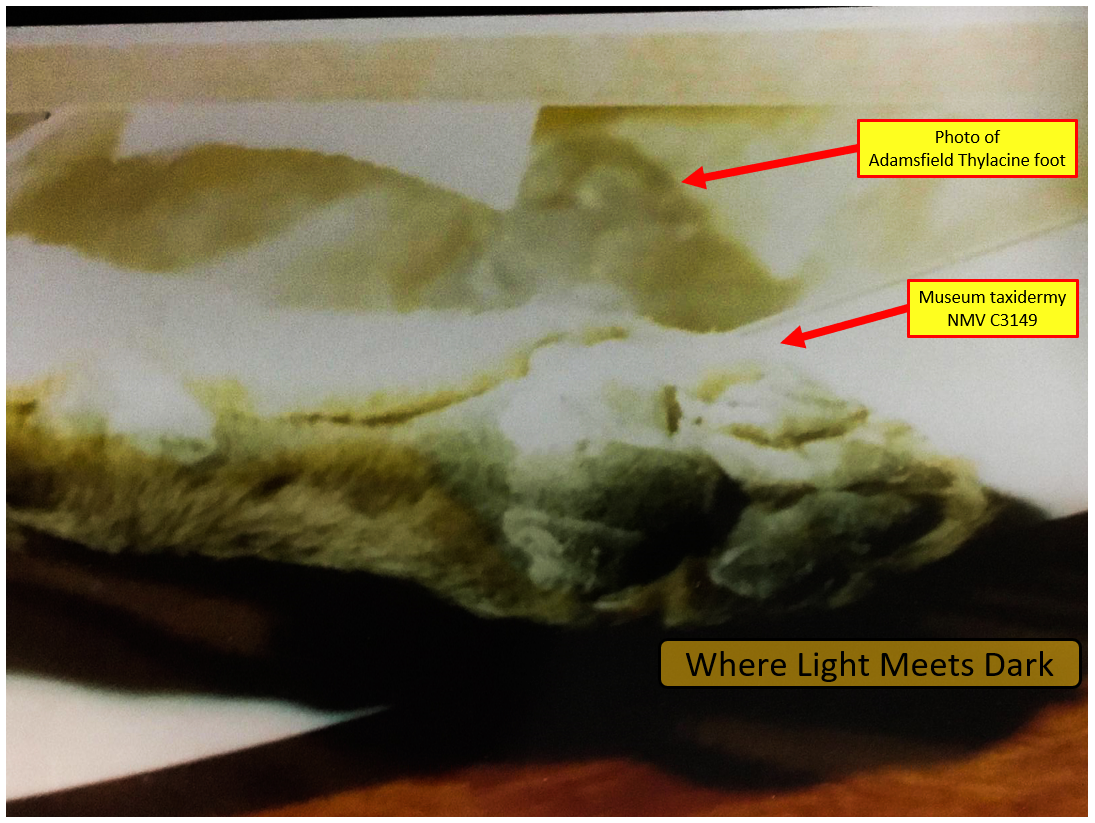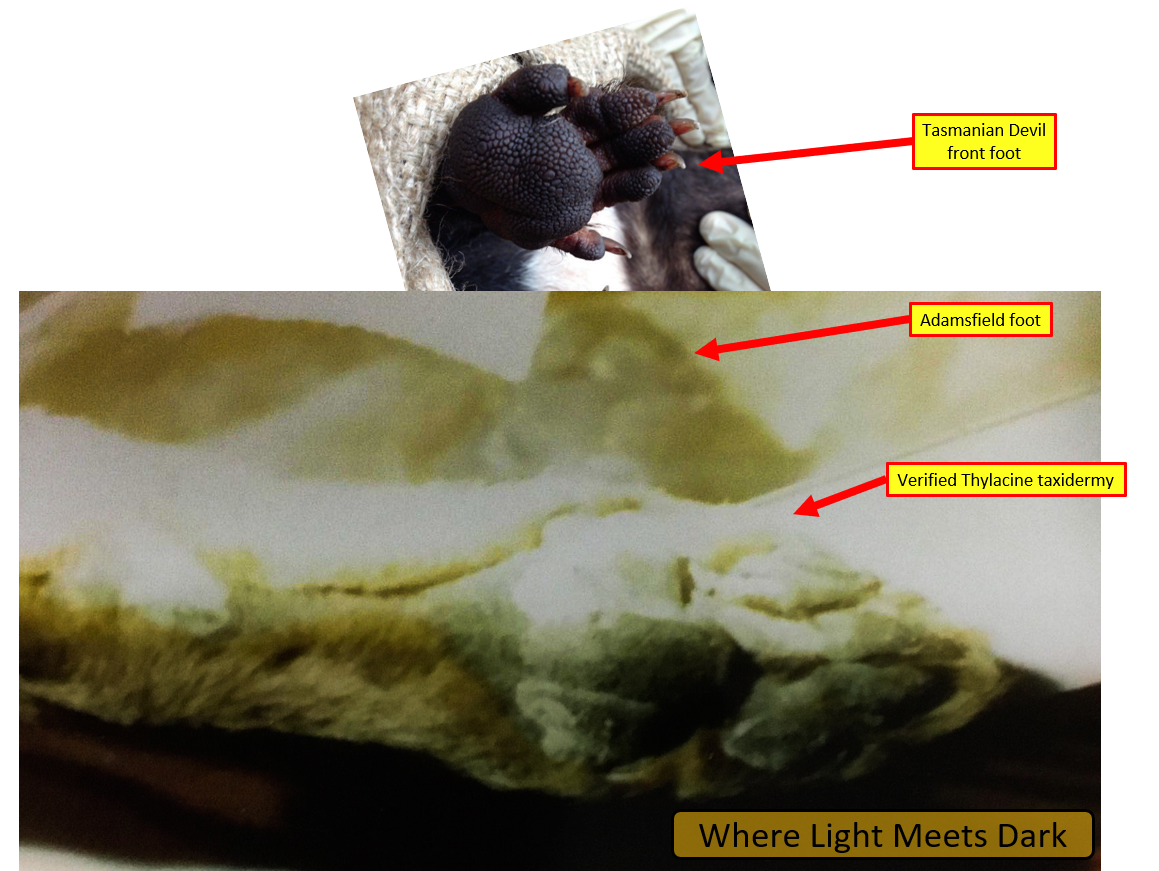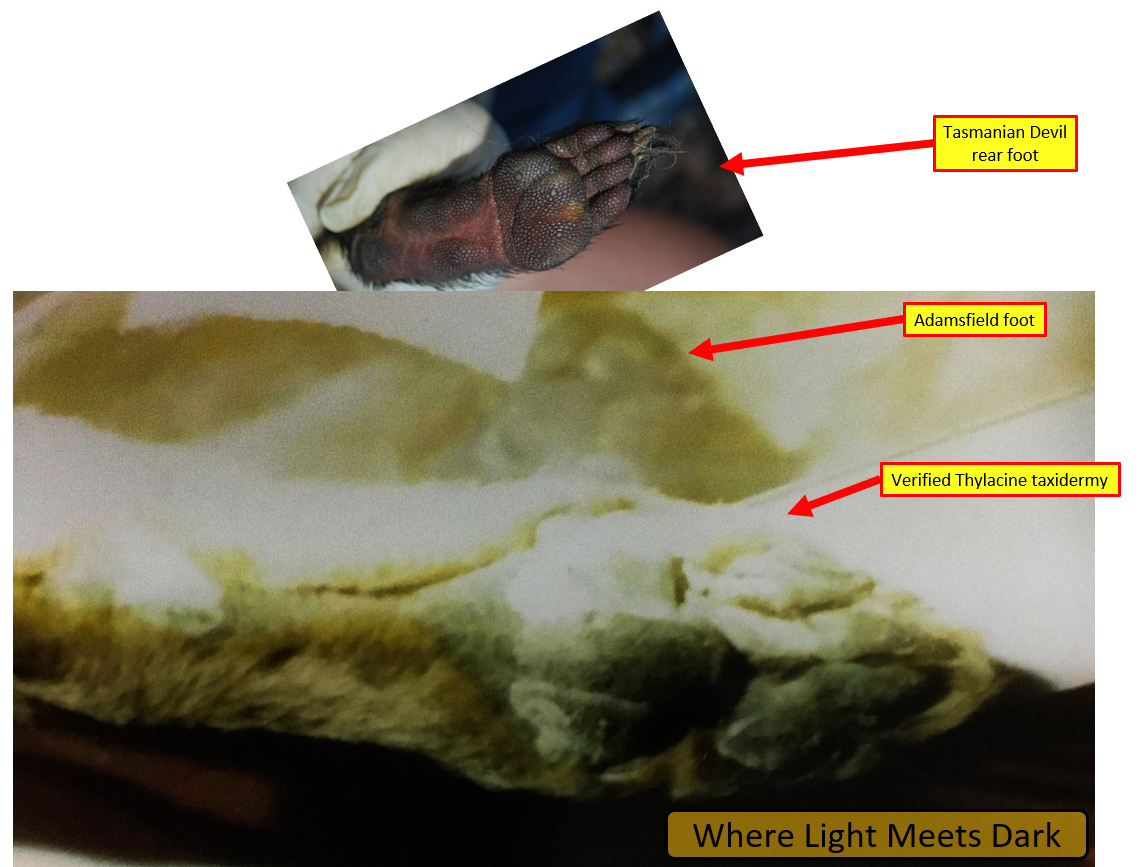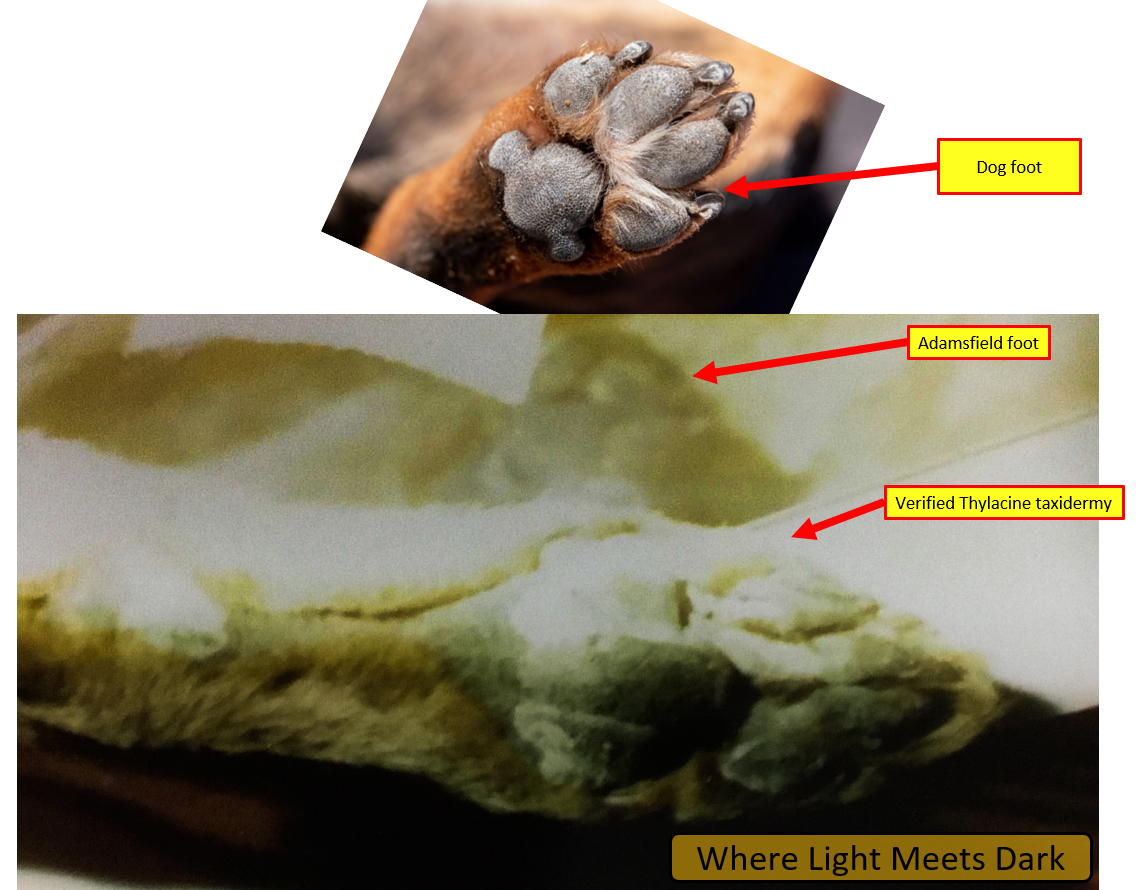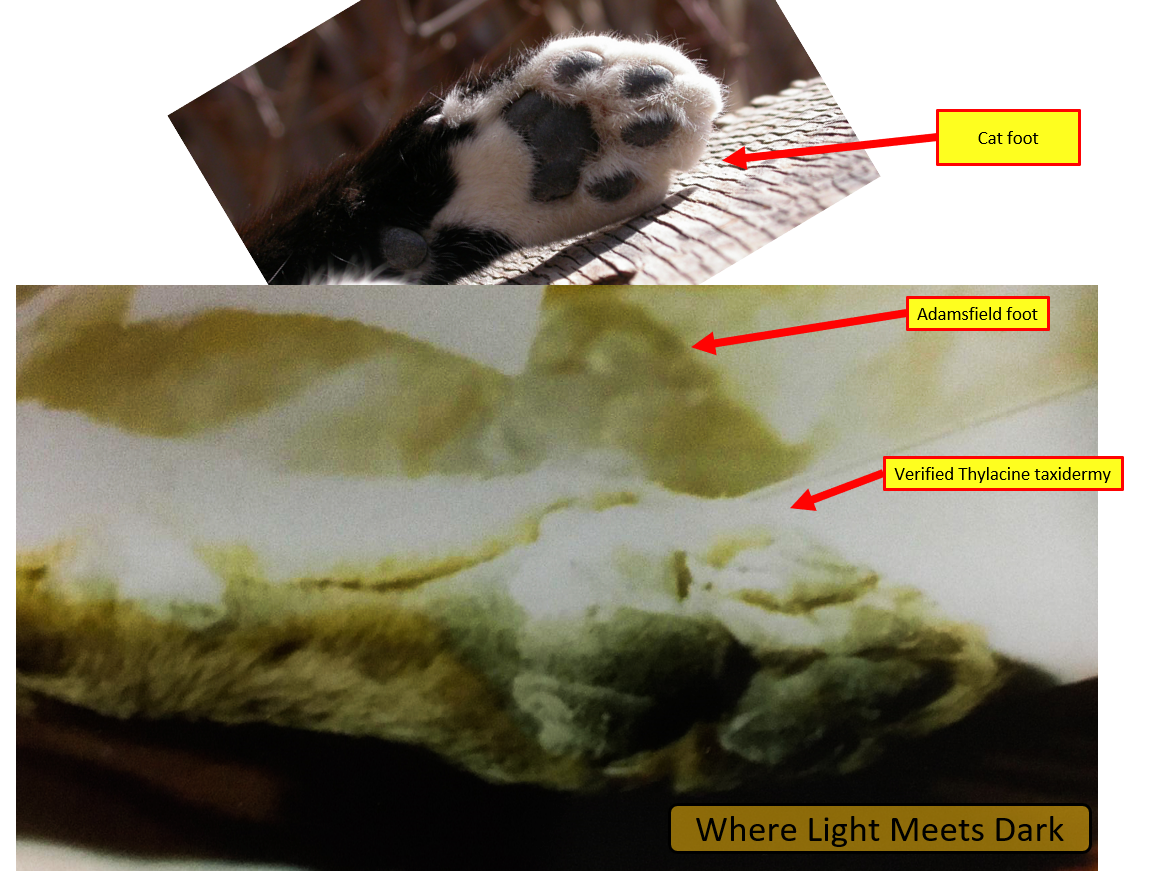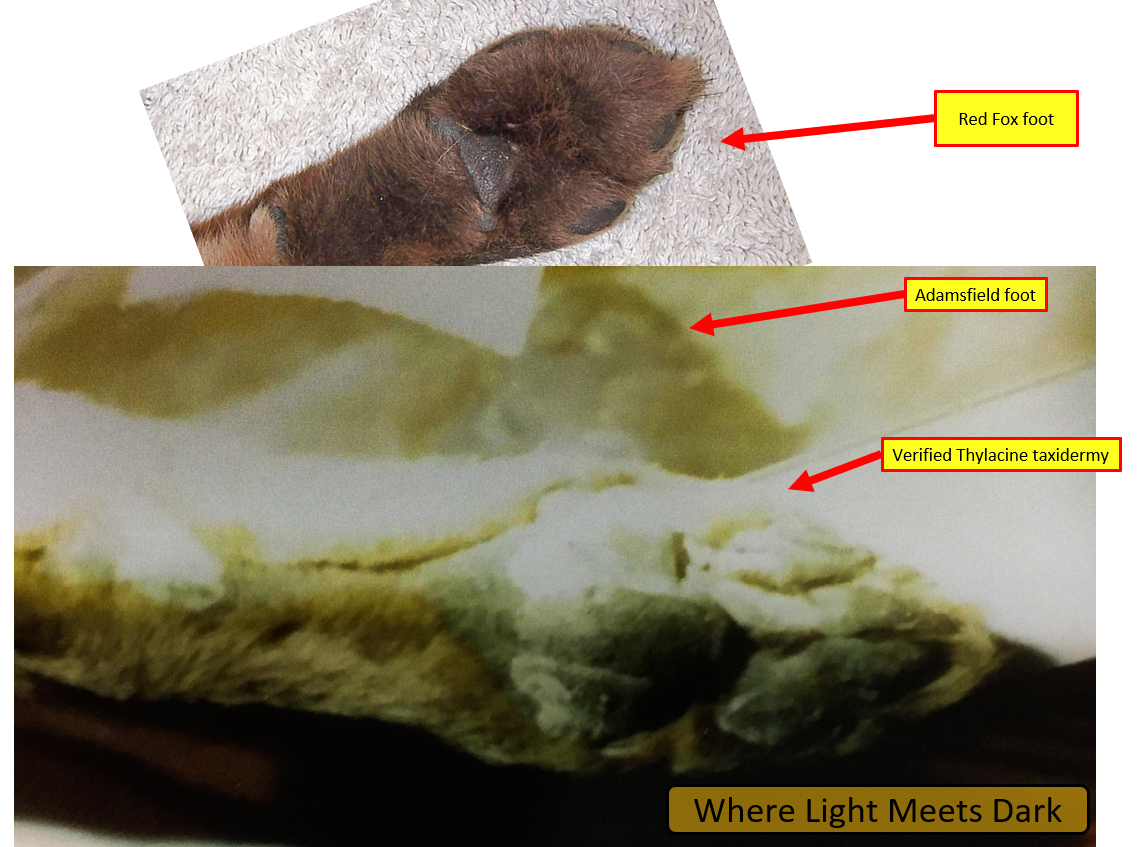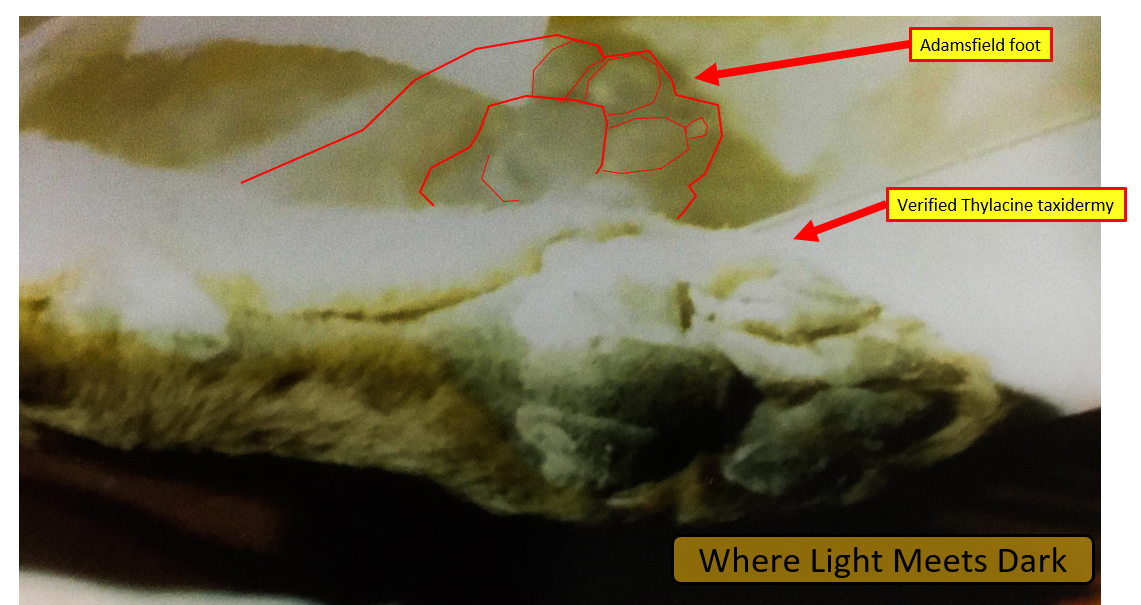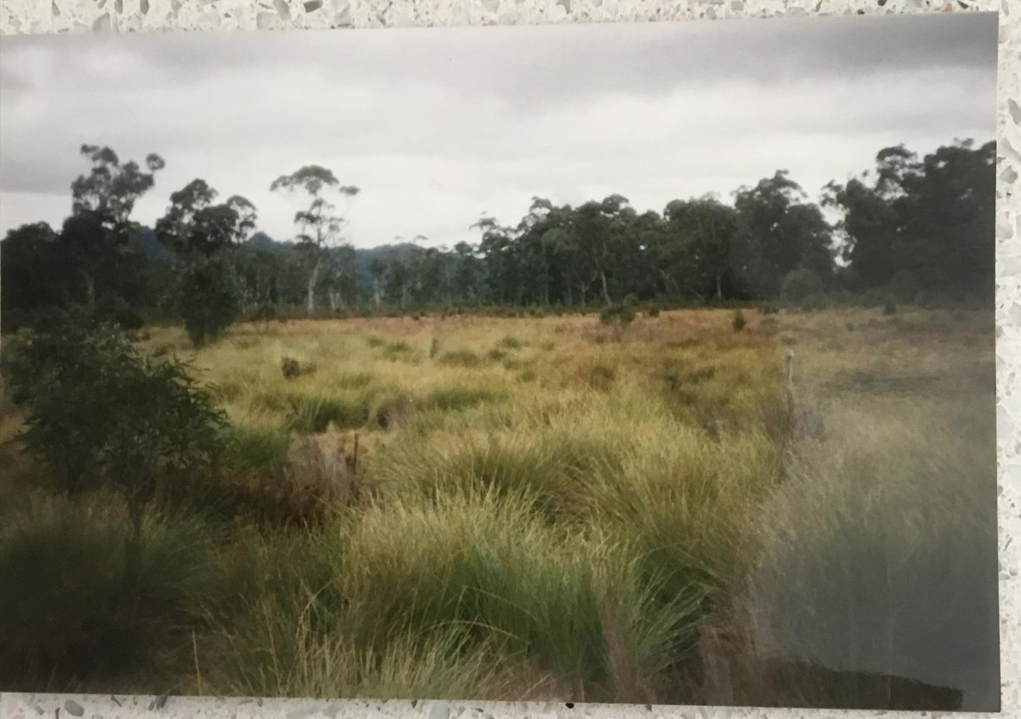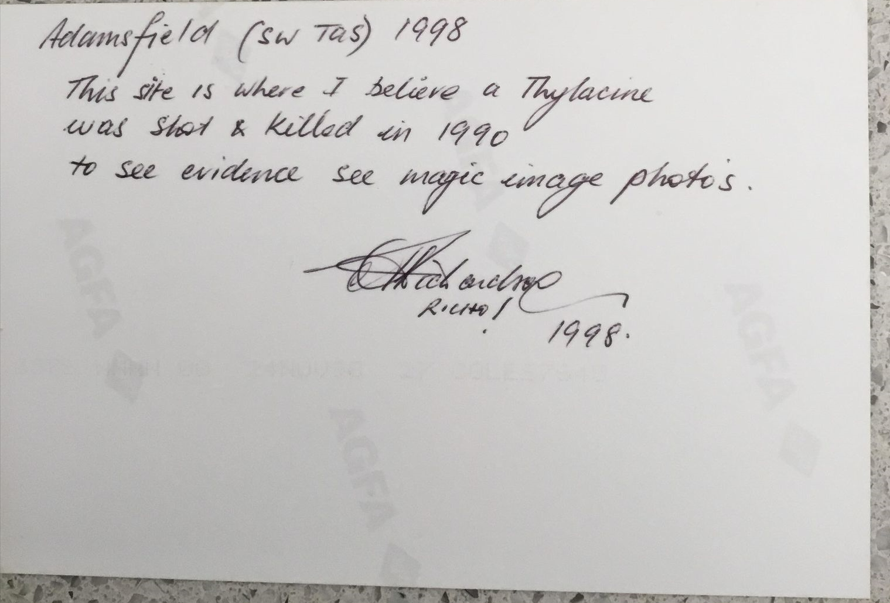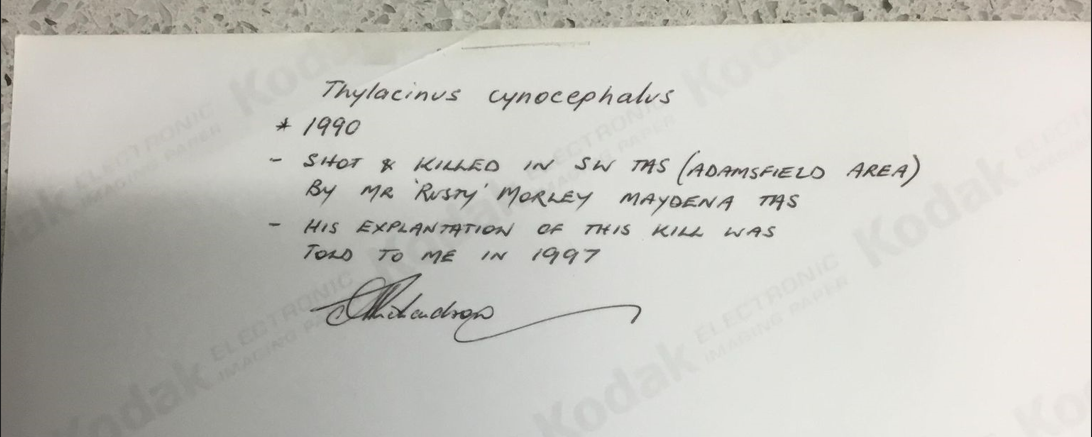Adamsfield thylacine - further evidence
Written with Adrian "Richo" Richardson
Overview
The basic sequence of events relating to the Adamsfield Thylacine follows -
- A Tasmanian Tiger was shot dead near Adamsfield, Tasmania, in 1990.
- One or more photographs of the carcass were taken.
- The shooter (or shooters) wished to keep the incident confidential.
- Despite this, one of these photos was taken by an unknown person to Museum Victoria - in order to compare the foot depicted in the photograph with a verified Thylacine taxidermy's feet.
- This comparison between the taxidermy's feet and the photograph of the Adamsfield thylacine was then also photographed.
- Those final photographs - of the comparison made at Museum Victoria - have then made their way into the public domain, where we now consider their merits, along with the back story, as evidence for the persistence of the Tasmanian Tiger to 1990 in Tasmania.
Two prior articles have been published by this author examining this evidence.
The first article was written before it was understood that the (Museum comparison) photographs being evaluated related to the comparison being made at Museum Victoria. At that time it was widely stated, alleged and believed, that the two photographs being considered were photographs of the Adamsfield Thylacine itself; but they were not.
The second article was written once that breakthrough in understanding became clear - the real and correct interpretation of those photographs is that they show a museum taxidermy lying on top of a photograph of the Adamsfield Thylacine itself.
In April 2023, this author published a post on social media summarising this interpretation of the evidence and asking readers to ask as many questions as possible in order to challenge the interpretation. That post was then shared - both by the author, and others - to multiple other online communities which in turn yielded further questions regarding this interpretation of the evidence. Those questions - and the answers - are the subject of a separate article on this website, under the heading of the Adamsfield Thylacine.
One name which has perhaps not yet widely been associated with these events, is that of Adrian "Richo" Richardson. Richo is himself a Thylacine researcher with an extensive history researching the Tasmanian Tiger. On many occasions over several years, this author (Chris Rehberg) and Richo have met and held discussions in relation to many aspects of the search for evidence for the Tasmanian Tiger, and each has supported the other in their work. Richo was, in fact, highly involved with the earliest research into claims that a Tasmanian Tiger was shot near Adamsfield in 1990 and was certainly one of the first people to interview Stan "Rusty" Morley - the alleged shooter - about these events.
It is with Richo's input and blessing that this article has been prepared - in order to provide a more comprehensive picture regarding the events that occurred during the 1990s relating to the Adamsfield Thylacine.
I (Chris) would like to express my gratitude to Richo for sharing the wealth of his research, experience and information in preparing this article. It is my belief that the Adamsfield events are incredibly important to the full picture of the history of the Thylacine in Tasmania.
Richo's background
Richo first began his own research into the Tasmanian Tiger's history and possible survival, in 1990. In about 1996, Richo teamed up with Col Bailey, who had been independently researching the Tasmanian Tiger's history and sighting accounts himself for over two decades. The pair worked together for a decade and Col's gratitude is expressed to Richo in the foreword to Col's book "Tiger Tales", which was published in 2001.
Col wrote:
- "to my friend and hunting mate Richo, thanks for sharing the dream with me"
Excerpt from the foreword of "Tiger Tales", by Col Bailey. Photo supplied by: Adrian Richardson
After ten years of collaboration, the pair parted ways in 2006 at Col's request, on account of differing views on how to respond to claims being made at that time by German tourist Klaus Emmerichs, who had alleged that he had taken two photographs of a Thylacine in Tasmania in 2005.
Working both independently and in partnership with Col, Richo has spent 33 years researching the Tasmanian Tiger. He has held discussions and meetings with many other notable Thylacine researchers including Eric Guiler, Ned Terry OAM, James Malley - who had partnered with Jeremy Griffiths on a multi-year search for the Tiger, Nick Mooney and others.
Richo has also conducted countless field trips of his own in search of evidence for the Tasmanian Tiger, deploying scores of camera traps into the Tasmanian wilderness at his own expense. Throughout the decades of his research, Richo has kept impeccable notes regarding his meetings, discussions, efforts and interpretations. Just a very few of these kinds of notes are reproduced in this article - as they relate to the Adamsfield Thylacine - but the full context shows a man who has impeccably documented his efforts for over thirty years.
A collection of items held by Richo. Photo supplied by: Adrian Richardson
The above image shows a copy of Col's book "Tiger Tales" in which Col wrote "To my friend and hunting mate Richo! Keeping the dream alive. With Best Regards & good wishes", signed Col Bailey, 20.1.01. Below this and to the right lies a photograph of Richo and Col together. To the left lies a pile of photographs relating to the Adamsfield Thylacine and held in Richo's collection. The uppermost photograph (ie. the one that is visible) we now understand shows the front feet of Museum Victoria's skin specimen having catalogue ID C3149. A small (15cm) metal ruler lies between the feet. The ruler was originally marked with inch increments but has had white tape wrapped around it in centimeter increments.
An example of the detail with which Richo keeps field notes. Photo supplied by: Adrian Richardson.
The above image provides some sense of the level of documentation maintained by Richo throughout his 30+ years researching the Thylacine. In this case the notes relate to a meeting between himself and Col with James Malley - who was Jeremy Griffiths' partner in their combined search for the Thylacine. The notes here recount how Richo and Col showed Col's photos to James - who immediately affirmed the photographs show a Thylacine foot. What none of these people realised at that time, however, was that the primary subject of the photograph was a museum taxidermy that had been photographed as part of a comparison between the actual Adamsfield photographs and a verified Thylacine foot, ie. the taxidermy's.
Another example of Richo's impeccable field notes - following a 1999 field trip to the Adamsfield area. Photo supplied by: Adrian Richardson.
In addition to this rich background of Thylacine research, Richo is both an ex-service member - having served in the Australian Army for 20 years - and a Justice of the Peace - and notes emphatically, that he does not lie. The details surrounding the Adamsfield account which he shares through this article, are the truth.
Richo on duty with the Australian Army, undated. Photo supplied by: Adrian Richardson
Photograph of Richo's Certificate of Appointment as Justice of the Peace. Photo supplied by: Adrian Richardson.
Richo investigates the Adamsfield incident
The Adamsfield Thylacine first came to Richo's attention in 1997 - just seven years after the alleged events and during the first year of Richo's collaboration with Col Bailey.
Photos showing Richo and Col in the Adamsfield area. Photo supplied by: Adrian Richardson.
The basic sequence of events surrounding Col and Richo's investigation of this incident have never been published. In brief, however, the following occurred:
- Col met with Rusty at Morley Hut, near Adamsfield.
- Rusty had agreed to show Col photographs relating to the dead Thylacine.
- A pile of photographs was placed down in front of Col.
- Col began to take photographs of the photos.
- After photographing the first two images, Rusty grabbed the pile of photos and would not allow Col to view them any further.
- It was emphasised to Col that trust had been broken and the expectation was that Col would maintain confidentiality over the whole encounter.
- Soon after this meeting, Richo reached out to Rusty to ask to meet in relation to the event.
- Rusty agreed and Richo met with Rusty, who was with two other people, at a bar close to Maydena - where both Rusty and Col lived at the time.
- During that meeting, Richo asked whether he could view the photos, but Rusty refused and said that the trust had been broken.
- Rusty, however, did recount the events that had occurred in 1990 and plainly stated directly to Richo that he shot the animal near Adamsfield.
One file of documents in Richo's collection. Photo supplied by: Adrian Richardson
Col Bailey first raised this account of the Adamsfield Thylacine publicly, when interviewed for the 1998 documentary "X Creatures: Beyond the Jaws of Extinction". Chris Packham interviews Col and mention is made of this incident occurring in 1991. In his book published 2013, Col gives the year 1990. It is clear from Richo's documentation (both the note in the image above, and other documents) that the year in question is definitively 1990. The date of 1991 was given in error.
In the interview by Packham, Bailey states "This [pair of photographs] came from down in the southwest of the state and it's an actual thylacine foot that was shot in 1991". We now know that not only was the year quoted in error, but the main subject matter of those two photographs was in fact the Museum Victoria taxidermy. Given how events unfolded - with Col quickly photographing the first photos shown to him by Rusty, and then Rusty taking the pile of photographs away and refusing to disclose more information about the incident - it is understandable as to why Col came to believe that those two photos were alleged to be showing the actual Adamsfield Thylacine that he and Rusty were discussing.
In short, Col had heard about this Tiger being shot and managed to secure a meeting with Rusty in order to see the photographs. Rusty met with Col and began showing the photographs. Col has seen the feet in the first two photographs and instantly recognised them as being Thylacine. It would seem in all probability that Col has made the assumption Rusty was showing him the Adamsfield Thylacine's feet and therefore Col states as much to Chris Packham - that these are the feet of the Adamsfield Thylacine.
In reality, however, it has been established that the primary subject of those two photographs is Museum Victoria Thylacine taxidermy skin with catalogue number C3149.
At this stage of the analysis, it would be understandable to draw the conclusion that the entire story was a hoax. However one of the two photographs shown by Rusty to Col shows the taxidermy foot lying on a further photograph. It is my (Chris') contention that this photograph lying underneath the taxidermy is a genuine photograph of the Adamsfield Thylacine.
Higher resolution image
Given the above provenance of the two photographs shown by Col to Chris Packham in the X Creatures documentary - that is, that Col took two photographs of two photographs shown to him by Rusty - a few further details become clear.
Perhaps the most important of these is that the photos being shown to Col were already photos of the museum taxidermy. That is, a photo of the Adamsfield Thylacine foot had already been taken to Museum Victoria for comparison with a taxidermy before Col had seen any evidence of this incident.
There remain unanswered questions around who took that photo to the museum and why, but ultimately we can also conclude that Rusty himself held copies of those photographs (ie. the photos taken at the museum). Museum Victoria does not hold any records of access to specimens from the 1990s.
Additionally, as Col was working together with Richo on this investigation, Richo too has retained high resolution copies of the photographs taken by Col.
High resolution copy of Adamsfield "Photo B" showing the Adamsfield Thylacine foot photo and Museum Victoria specimen C3149. Source photo supplied by: Adrian Richardson; annotated copy by WLMD.
The image above is an unaltered high resolution copy of the Adamsfield "Photo B" (see the initial analysis for naming of photographs relating to this incident) as supplied by Richo. The only modifications have been to add the labels which (hopefully definitively) clarify that the Museum Victoria specimen C3149 was laid on top of a photograph of the Adamsfield Thylacine's foot.
Enhanced version of high resolution copy of Photo B. Source photo supplied by: Adrian Richardson. Image enhancement and labels by WLMD.
This copy of the high resolution photograph has been enlarged slightly and exposure, contrast and white-point settings have been modified, with the use of a gradated filter, in order to darken the area of the photo showing the Adamsfield Thylacine foot and to increase contrast in this area also.
It is my contention (Chris) that there are sufficient features visible in the upper foot to categorically conclude that photograph shows a Thylacine foot - to the exclusion of other realistic Tasmanian candidates, namely Cat, Dog, Fox and Devil.
A key feature, that is clearly visible, is the triangular patch of skin behind the plantar pad - seen here in both feet. This skin patch is absent in all of Cat, Dog, Fox and Devil feet. A more comprehensive analysis that takes into account digital configuration (using a lower resolution copy of Photo B) has been given in an earlier article.
Nevertheless, for completion, here are side by side comparisons of the Adamsfield foot with Devil (front and back), Dog, Cat and Red Fox feet.
Comparison between Tasmanian Devil front foot and the Adamsfield foot. Copyright: see References section.
Comparison between Tasmanian Devil rear foot and the Adamsfield foot. Copyright: see References section.
Comparison between Dog foot and the Adamsfield foot. Copyright: see References section.
Comparison between Cat foot and the Adamsfield foot. Copyright: see References section.
Comparison between Red Fox foot and the Adamsfield foot. Copyright: see References section.
Finally, the image below presents an approximate tracing of the foot pad features of the Adamsfield foot.
High resolution copy of the Adamsfield foot with key morphological features traced. Original photo supplied by: Adrian Richardson. Illustration and label overlays: WLMD.
It is interesting to reflect on something Rusty said in his interview with the Thylacine Research Unit (TRU) in 2013:
- " I told one person what I'd found and everything and I gave him a small photograph - part thereof, you know - but, um, he made his own stories up about it, you know."
With both Rusty and Col having passed on, there is no way to confirm what Rusty meant, but it seems probable that Rusty is referring to Col's acquiring copies of two of his photographs and then drawing the conclusion that the taxidermy was the Adamsfield Thylacine itself.
One contention that Rusty had with Col's account of events was that Rusty claimed he found the Thylacine already deceased. In the TRU interview, Rusty states:
- "I went up into the rocky outcrops and ... there was a carcass of a tiger. It was a small one, you know, but striped; you could still see the stripes and everything. But, um, I took a couple of phot- I didn't take a photograph of the whole animal, I did it in sections."
From this line we hear Rusty say the animal was small. In viewing the high resolution image above, we see the digits lie more closely toward the plantar pad than they do on the taxidermy. However, might this be explained by the animal being young? It is difficult to ascertain. Images of young thylacine feet held in the International Thylacine Specimen Database show some measure of desiccation - as also seems evident in the adult foot here - producing a narrowing of the digits. Prospectively, the digits on a living Tiger might have been much fuller - as seen in the Adamsfield photo, above. Images MRB2, MRB10, HBZ5 and NZW3 in the Thylacine Image Registry (TIR) support the view that digital pads on live Thylacines are fuller than as seen in the taxidermy above. This being the case suggests the foot in the Adamsfield photograph is from an animal only recently deceased.
A second interesting point is Rusty's statement that he "didn't take a photograph of the whole animal" and that he did it in sections.
Richo has stated that in the account verbally given to him directly by Rusty during their meeting, Rusty said he shot the Tiger in the head at point blank range. The incident came about when Rusty's hunting dog ran back cowering to Rusty. That was not something his dog had ever done. Rusty moved forward to investigate and used the muzzle of his weapon to pull aside some button-grass foliage. The Tiger was sleeping beneath and Rusty immediately shot.
It is not difficult to imagine that such a shot would have disfigured the Thylacine's head significantly. Any photograph showing the whole animal would clearly also reveal the fact that the animal had been shot dead - in a National Park, no less.
Conclusion
Is the Adamsfield account proof that the Tasmanian Tiger survived until at least 1990 in Tasmania?
In my opinion (Chris), there are two key questions that must be answered:
- Does the photograph of the Adamsfield Thylacine foot definitively show the foot of a Thylacine?
- If so, then can the provenance of that photograph be definitively tied back to an animal killed near Adamsfield in 1990?
It is my view (Chris) that the upper foot seen in Photo B plainly shows a feature that is only present in the Tasmanian Tiger, among all candidate species in Tasmania - the triangular patch of skin behind the plantar pad. All other features visible within the photograph are consistent with Thylacine also, notably: skin colour; fur colour; proportions of plantar pad; proportions of digital pads; arrangement of digital pads; and extent of fur extending beyond the digital pads (a well documented feature of Thylacine feet).
If it is agreed that the upper foot in Photo B is that of a Thylacine, then we come to the question - where on earth did that image come from? Below is a list of some details that have come to light through this investigation - an investigation that has required multiple researchers to continually evaluate the evidence over a period spanning almost two decades:
- Rusty claims he is responsible for the photographs that Col published
- Rusty acknowledges that he took photographs of the dead animal one section at a time, and no photograph of the entire animal
- Richo asserts that Rusty told him directly that he shot the Thylacine
- Although Rusty disputed that the Thylacine was shot, he did not dispute Col's claim that there was in fact a freshly dead Thylacine in 1990
- Richo's documentation confirms that the date in question is 1990 - despite the earlier mistaken date of 1991 being noted
- Chris' second analysis of the Adamsfield evidence clarified that the main subject of photos A and B was Museum Victoria specimen C3149
- But what also became clear was that the museum specimen was lying on top of the photograph we now understand to be "the Adamsfield Thylacine photograph"
- This means that someone went to the effort of taking that foot photo all the way to Museum Victoria in order to compare it with a museum taxidermy - some time before or during 1996, when it was then shown to Col.
- The un-desiccated digital pads suggest the animal in that photo was only recently deceased when photographed.
It is on the basis of the weight of the testimonial evidence - alongside a proper understanding of the sequence of events (which, unfortunately, was tarnished for 20 years due to the mis-held belief that Photos A & B were of the Adamsfield Thylacine itself) - that has led me (Chris) to state I am convinced the Tasmanian Tiger survived until 1990, at least, in Tasmania.
A note on Rusty's discovery
My (Chris') first conversations with Rusty regarding the Thylacine generally, occurred approximately during 2010. At that time I ran a business that sold camera traps and Rusty was one of my earliest customers. This would have been about three years before the Adamsfield story was told in Col's book. Even though Col recounted the story in the 1998 documentary, it did not gain widespread recognition until after the book was published in 2013 - most likely because the internet was still relatively new in 1998, but by 2013 there was ample opportunity for the story to spread amongst online interest groups. Further, following publication of Col's book, Rusty himself came forward to take ownership of the photographs and to provide information regarding the incident.
When Rusty and I chatted during 2010 I was not at all aware of the Adamsfield incident. I told Rusty I was interested in the prospect that the Tasmanian Tiger might survive and Rusty recounted the details of several encounters he claimed he had had with Tasmanian Tigers in Tasmania. As it turns out, Rusty himself had appeared in a documentary in 2003. The show was a series titled "Killer Instinct" and the episode was titled "Devils Island". It turns out that the accounts Rusty gave in Killer Instinct (2003), and to me personally (circa 2010) and to the Thylacine Research Unit (2013) were essentially consistent. These related to his earliest sighting of a Tasmanian Tiger while he was a teenager, through to finding and casting tracks.
It is my opinion that Rusty has been genuine in his accounts - given over the course of at least a decade - when he has talked of having something like five or six encounters with Tasmanian Tigers throughout his lifetime. It must be remembered that for many years, Rusty was employed by the government to track, trap and kill cats within national parks, and that his training in the military was as a tracker. Rusty recounted a story to me directly of having spent six weeks hiking from the Adamsfield region to Tasmania's west coast and back with nothing more than a hunting knife to sustain him. Rusty was clearly a highly skilled bushman and tracker who spent an enormous amount of time solo in the Tasmanian wilderness. Indeed the Clark and Morley Huts just outside Adamsfield bear his name and were under his occupation for years.
I have made plain that I am of the belief that the Adamsfield incident did occur and that a Thylacine was shot. I acknowledge and recognise that Rusty affirmed that the Tiger he photographed was found by him already being deceased.
I believe Rusty was a man who had his morals and loyalties and whose intentions for the Thylacine were in the right place - he repeatedly stated that he did not want people trudging through the bush trying to seek out and interfere with the Tasmanian Tiger. The perspective he shared was that from time to time, during the course of his work, he came across evidence of the species' survival, even though proving that fact was never a concern for him.
The social-political context in which Rusty photographed a freshly deceased Thylacine was, in 1990, a complex one. It is completely understandable, in my view, that he would choose to keep the incident confidential.
Rusty was completely generous with his time and information with me through many conversations over many years. He provided me with copies of the plaster casts that he showed in the Killer Instinct documentary. The first time I heard animal vocalisations during a field trip which I thought could match those of a Tiger, I spoke with Rusty about them who confirmed to me that the sounds I was describing matched calls he had heard which he believed to be the Tiger, and the location I was describing matched the location at which he too had heard such vocalisations. I am grateful to Rusty for his input into my own research in prior years and for always entertaining my conversations and discussions on all things Thylacine.
Despite all the confusion and complexity surrounding the Adamsfield evidence, it is my hope that Rusty be credited for obtaining evidence that confirmed the Thylacine's persistence in Tasmania until 1990.
To put this into context, David Fleay, an incredibly qualified naturalist and zoo director, found extensive Thylacine tracks in Tasmania in 1945-6. Nick Mooney, following the 2 year government search triggered by Hans Naarding's 1982 sighting, wrote that the Tasmanian Tiger had survived in northwestern Tasmania until 1982, at least. It is only eight years after this that Rusty's documentation of a Tasmanian Tiger in Adamsfield takes place.
A photograph of the Adamsfield area. Photo supplied by: Adrian Richardson
Reverse side of the photo of the Adamsfield area with signed statement by Richo noting "This site is where I believe a Thylacine was shot & killed in 1990" and dated 1998. Photo supplied by: Adrian Richardson.
Reverse side of a photograph with a hand-written signed statement by Richo stating Rusty explained the kill to him in 1997. Photo supplied by: Adrian Richardson.
References
Images used in side by side comparisons
Tasmanian Devil front foot: Uncredited, at https://www.pinterest.com.au/pin/223139356522654861/
Tasmanian Devil hind foot: Uncredited, at http://danielhoops.com
Dog foot: Credited to: Depositphotos/DasyaDasya, at https://youdidwhatwithyourweiner.com/how-to-keep-your-dogs-paw-pads-from-tearing-or-getting-cut/
Cat foot: Uncredited, at https://thecatsite.com/threads/cat-paw-pads-that-look-like-beans.341818/page-5
Red Fox foot: Credited to: Caroline Gould, at https://www.wildlifeonline.me.uk/animals/article/red-fox-appearance
Revisions
Published 1 May 2023.
Citing this article
Rehberg, C. & Richardson, A. (2023). Adamsfield Thylacine - further evidence, Accessed: date,
